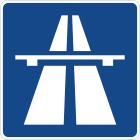
Back أوتوبان Arabic Автобан Bashkir Аўтабан Byelorussian Аўтабан BE-X-OLD Autobahn Catalan Dálnice v Německu Czech Германи автомагистралĕсем CV Tyske motorveje Danish Autobahn (Deutschland) German Γερμανικός Αυτοκινητόδρομος Greek
This article has multiple issues. Please help improve it or discuss these issues on the talk page. (Learn how and when to remove these messages)
|
| Bundesautobahn | |
|---|---|
 | |
 A map of the German Bundesautobahn network | |
| System information | |
| Maintained by Die Autobahn GmbH des Bundes | |
| Length | 13,192 km (2021) (8,197 mi) |
| Formed | 1932 |
| Highway names | |
| Autobahns: | Bundesautobahn X (BAB X or A X) |
| Website | www |


The Autobahn (IPA: [ˈaʊtoˌbaːn] ⓘ; German pl. Autobahnen, pronounced [ˈaʊtoˌbaːnən] ⓘ) is the federal controlled-access highway system in Germany. The official term is Bundesautobahn (abbreviated BAB), which translates as 'federal motorway'. The literal meaning of the word Bundesautobahn is 'Federal Auto(mobile) Track'.
Much of the system has no speed limit for some classes of vehicles.[1] However, limits are posted and enforced in areas that are urbanised, substandard, accident-prone, or under construction. On speed-unrestricted stretches, an advisory speed limit (Richtgeschwindigkeit) of 130 kilometres per hour (81 mph) applies.[2] While driving faster is not illegal in the absence of a speed limit, it can cause an increased liability in the case of a collision (which mandatory auto insurance has to cover); courts have ruled that an "ideal driver" who is exempt from absolute liability for "inevitable" tort under the law would not exceed the advisory speed limit.
A 2017 report by the Federal Road Research Institute reported that in 2015, 70.4% of the Autobahn network had only the advisory speed limit, 6.2% had temporary speed limits due to weather or traffic conditions, and 23.4% had permanent speed limits.[3] Measurements from the German state of Brandenburg in 2006 showed average speeds of 142 km/h (88 mph) on a 6-lane section of Autobahn in free-flowing conditions.[4]
- ^ Jeremic, Sam (16 September 2013). "Fun, fun, fun on the autobahn". The West Australian. Retrieved 17 September 2013.
- ^ "Verordnung über eine allgemeine Richtgeschwindigkeit auf Autobahnen und ähnlichen Straßen". Retrieved 11 December 2022.
- ^ "BASt 2017 – Publikationen – Tempolimits auf Bundesautobahnen 2015". www.bast.de.
- ^ Cite error: The named reference
studie_tempolimitwas invoked but never defined (see the help page).